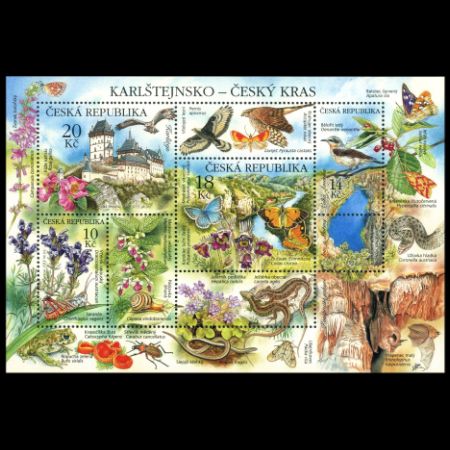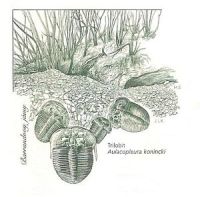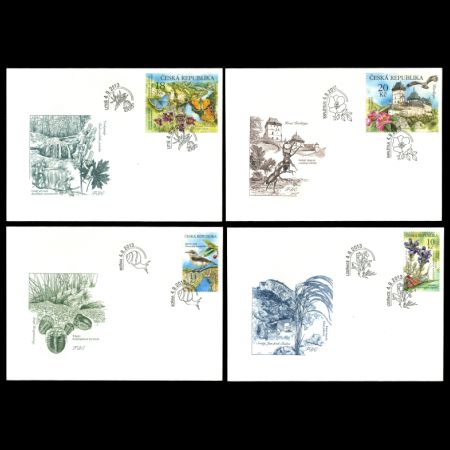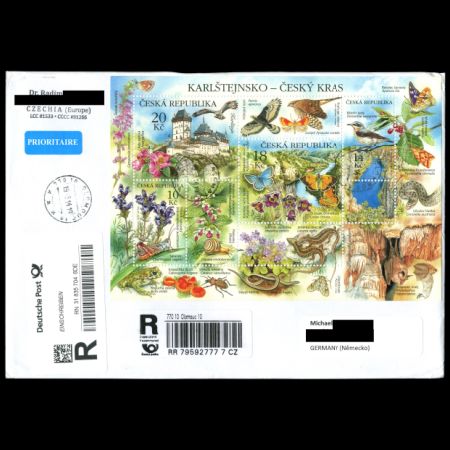| Issue Date | 04.09.2013 |
| ID | Michel: Stanley Gibbons: UPU: CZ027.13 Category: Ot |
| Author | Graphic design: Libuše and Jaromír Knotek Engraver: Martin Srb |
| Stamps in set | 4 |
| Value |
KC20 - Karlštejn castle and Rosa gallica KC18 - Polyommatus coridon, Colias crocea and Pulsatilla pratensis KC14 - Oenanthe oenanthe KC10 - Dracocephalum austriacum |
| Size (width x height) | Stamps: 50x40 mm, 23x40 mm; Mini-sheet 177 x 121 mm |
| Layout | Mini-sheet of 4 stamps + 4 coupons (se-tenant) |
| Products | FDC x 3 |
| Paper | |
| Perforation | 12 |
| Print Technique | |
| Printed by | Post Printing House |
| Quantity | |
| Issuing Authority | Czech Post |

The Karlštejn National Nature Reserve (1,547 ha) was established in 1955. It covers the area between the town of Beroun and the villages of Vráž, Mořina, Karlštejn and Srbsko, within the Český kras (Bohemian Karst) Protected Landscape Area (128 km2) established later in 1972. The prevailing geological profile consists of limestone rocks with jagged karst canyons, ravines and numerous caves. The area was first populated as early as 40 thousand years ago. The thermophilic plants growing in the reserve are typical of the Mediterranean regions. Some local species, such as the pyramidal orchid (Anacamptis pyramidalis), the Austrian dragonhead (Dracocephalum austriacum), and rare orchid species, are unique and cannot be found anywhere else in Bohemia. Local animals include numerous rare species, such as over 200 species of carabid beetles; two amphibians, the great crested newt (Triturus cristatus) and the less frequent Alpine newt (Triturus alpestris); and the endangered wallcreeper (Tichodroma muraria) as a representative of birds.
 The area
boasts many
precious, geologically significant profiles and world-famous fossil
deposits shared with the neighbouring Bohemian Karst area. The
prevailing sedimentary structures contain numerous karst caves.
The Koněprusy Caves, hidden in the Zlatý kůň (Golden Horse) hill about
5 km far from Beroun, are the best known ones. Visitors can see about
600 meters of the more than 2 kilometre long caves. Inside,
archaeologists found many animal bones dating back more than half a
million years and human bones about 13 thousand years old.
A 15th
century counterfeiter’s workshop was discovered on the upper level of
the caves.
The greatest tourist attraction is the medieval castle Karlštejn, also
known as Karlův Týn. On the Czech and Roman King Charles IV’s order,
the foundation stone was laid by the Prague Archbishop Arnošt of
Pardubice himself in 1348 on the hill later named “Kněží hora” or
“Priest’s Hill”. The originally private residence of the king with its
outbuildings was gradually changed into a fortified castle used to
safeguard the Czech and imperial crown jewels. The castle’s main
buildings include the 80 m high “Well Tower” (Studniční věž);
the frequently rebuilt “Burgrave House” (Purkrabství);
the “Imperial Palace” (Císařský palác) with its
audience chamber and state rooms; the “Marian Tower” (Mariánská
věž) with the Church of the Virgin Mary; and the highest “Big
Tower” (Velká věž) with the Chapel of the Holy
Cross, the former safe place for the Imperial and later also Czech
crown jewels kept there until 1619. The area
boasts many
precious, geologically significant profiles and world-famous fossil
deposits shared with the neighbouring Bohemian Karst area. The
prevailing sedimentary structures contain numerous karst caves.
The Koněprusy Caves, hidden in the Zlatý kůň (Golden Horse) hill about
5 km far from Beroun, are the best known ones. Visitors can see about
600 meters of the more than 2 kilometre long caves. Inside,
archaeologists found many animal bones dating back more than half a
million years and human bones about 13 thousand years old.
A 15th
century counterfeiter’s workshop was discovered on the upper level of
the caves.
The greatest tourist attraction is the medieval castle Karlštejn, also
known as Karlův Týn. On the Czech and Roman King Charles IV’s order,
the foundation stone was laid by the Prague Archbishop Arnošt of
Pardubice himself in 1348 on the hill later named “Kněží hora” or
“Priest’s Hill”. The originally private residence of the king with its
outbuildings was gradually changed into a fortified castle used to
safeguard the Czech and imperial crown jewels. The castle’s main
buildings include the 80 m high “Well Tower” (Studniční věž);
the frequently rebuilt “Burgrave House” (Purkrabství);
the “Imperial Palace” (Císařský palác) with its
audience chamber and state rooms; the “Marian Tower” (Mariánská
věž) with the Church of the Virgin Mary; and the highest “Big
Tower” (Velká věž) with the Chapel of the Holy
Cross, the former safe place for the Imperial and later also Czech
crown jewels kept there until 1619. |
References: Czech Post
 |
|
Latest update 06.02.2018
Any feedback, comments or even complaints are welcome: [email protected] (you can email me on ENglish, DEutsch, or RUssian)

